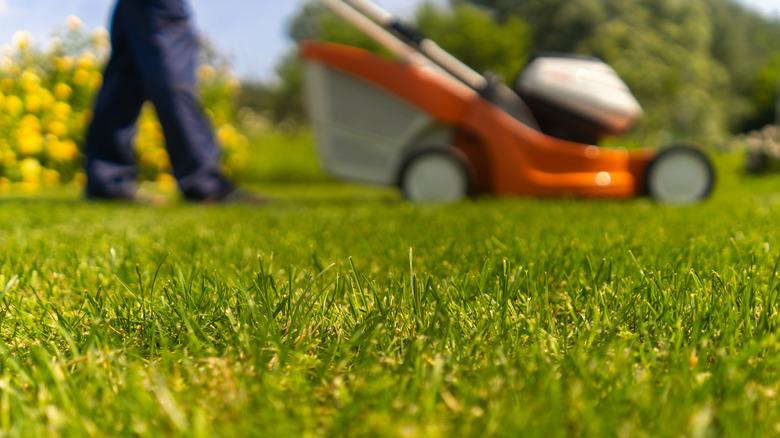Sorry, But You Shouldn't Mow Your Lawn In A Repeating Pattern. Here's Why
For many people, maintaining a healthy lawn is not only a household duty but a source of pleasure and pride. Some turf enthusiasts even enjoy cutting their grass into eye-catching designs. The University of Minnesota explains that patterns are created when mowing the lawn because the blades of grass are encouraged to bend in one direction, allowing light to bounce off them and give a light-and-dark effect. Take care, though! Mowing in the same way every time can result in some unsightly and unhealthy side effects for your lawn. But what exactly happens to your grass?
When a mower is used in the same design each time — whether in stripes, circles, or any other shape — the wheels of the mower end up running over the same ground repeatedly. This means that the wheels can create ruts in the soil, resulting in unattractive dips in the yard or even areas where grass is less able to grow. Additionally, when mowed in an identical pattern frequently, the blades of grass are pressed in the same direction time and time again. This can cause them to be permanently bent over to one side, resulting in a flatter, less healthy lawn. So, how do you avoid these unwanted results?
What to do instead
After taking the time to mow your lawn, the last thing you want is to realize that your efforts have resulted in ditches forming in the ground or turf that is flat and unhealthy. In order to avoid this, it is a good idea to vary the way you cut your grass every time you pull that mower out of the shed. If you are still wanting an attractive design to appear in your lawn, perhaps consider switching it up between different shapes. By rotating between designs, your grass will have the chance to recover and bend in different directions, encouraging it to grow tall and strong.
If you're unsure which design you may want to try next in order to give your lawn a little variety, it can be helpful to remember that the pattern can be used to draw the eye to a specific area. For example, if you have a landscaping feature such as a pond or some of the best flowering trees you'd like to call attention to, an alternating stripe design can be used to highlight that area. Alternatively, creating curved lines gives your lawn a softer, more organic look, though it may take a little practice to get the curves even. If you're feeling brave, you could even opt for a more intricate design such as circles, diamonds, or even a checkerboard. These will add unique visual appeal to your lawn and, by creating variety, can help your turf grow stronger than ever before, no matter the type of grass you have.

